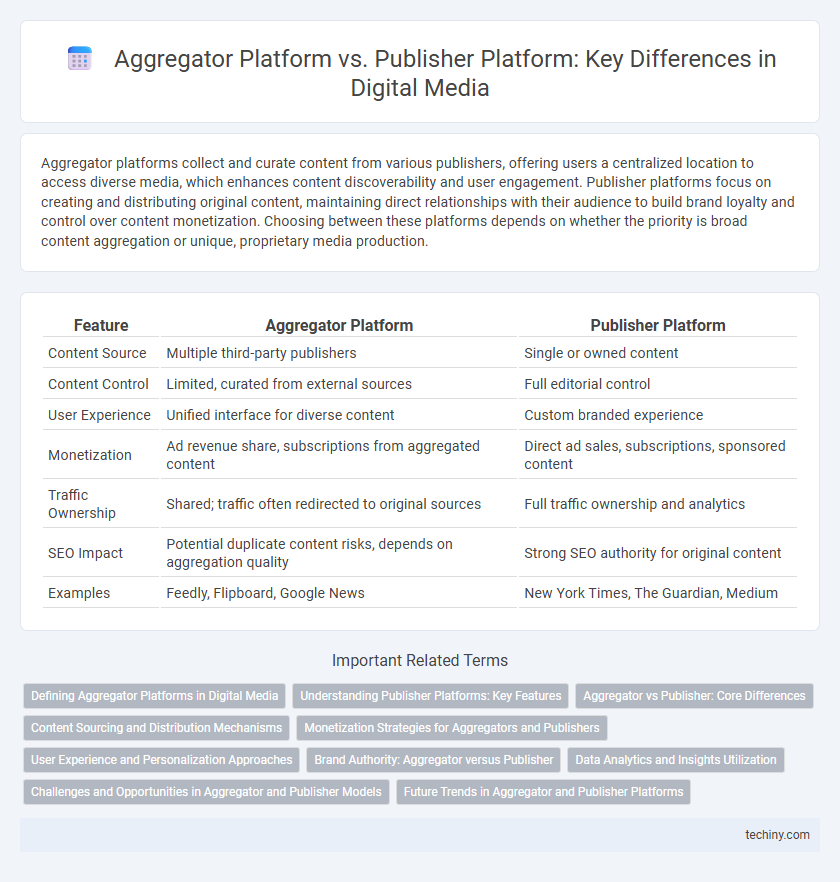Aggregator platforms collect and curate content from various publishers, offering users a centralized location to access diverse media, which enhances content discoverability and user engagement. Publisher platforms focus on creating and distributing original content, maintaining direct relationships with their audience to build brand loyalty and control over content monetization. Choosing between these platforms depends on whether the priority is broad content aggregation or unique, proprietary media production.
Table of Comparison
| Feature | Aggregator Platform | Publisher Platform |
|---|---|---|
| Content Source | Multiple third-party publishers | Single or owned content |
| Content Control | Limited, curated from external sources | Full editorial control |
| User Experience | Unified interface for diverse content | Custom branded experience |
| Monetization | Ad revenue share, subscriptions from aggregated content | Direct ad sales, subscriptions, sponsored content |
| Traffic Ownership | Shared; traffic often redirected to original sources | Full traffic ownership and analytics |
| SEO Impact | Potential duplicate content risks, depends on aggregation quality | Strong SEO authority for original content |
| Examples | Feedly, Flipboard, Google News | New York Times, The Guardian, Medium |
Defining Aggregator Platforms in Digital Media
Aggregator platforms in digital media consolidate content from various publishers, offering users a centralized browsing experience without creating original material. These platforms leverage algorithms to curate personalized content feeds, enhancing user engagement and retention by efficiently sorting diverse media sources. The value of aggregator platforms lies in their ability to drive traffic and amplify reach for multiple content creators simultaneously.
Understanding Publisher Platforms: Key Features
Publisher platforms offer robust content management systems that enable creators to efficiently organize, publish, and monetize digital media assets. These platforms provide detailed audience analytics, customizable layout options, and integrated advertising tools designed to maximize user engagement and revenue generation. Unlike aggregator platforms, publisher platforms prioritize direct content ownership and brand consistency, empowering publishers to maintain control over distribution and user experience.
Aggregator vs Publisher: Core Differences
Aggregator platforms compile content from multiple sources, offering users a wide range of options in one place, whereas publisher platforms focus on creating and distributing original content directly to their audience. Aggregators prioritize curation and efficient content discovery, utilizing algorithms to personalize user experience, while publishers emphasize brand identity, content control, and direct audience engagement. The monetization models also differ, with aggregators often relying on advertising and referral fees, and publishers generating revenue through subscriptions, sponsored content, and exclusive offerings.
Content Sourcing and Distribution Mechanisms
Aggregator platforms source content from diverse third-party creators, curating and distributing it through algorithms to targeted audiences across multiple channels. Publisher platforms primarily produce original content in-house, controlling the distribution to maintain brand consistency and direct audience engagement. Both models leverage digital media technologies but differ in content ownership, sourcing strategies, and distribution control, impacting scalability and monetization potential.
Monetization Strategies for Aggregators and Publishers
Aggregator platforms monetize by leveraging large-scale user data to optimize targeted advertising and subscription models, maximizing revenue through diversified content distribution. Publisher platforms focus on direct audience engagement, utilizing paywalls, sponsored content, and native advertising to enhance monetization while maintaining brand integrity. Both platforms employ programmatic advertising but differ in revenue sources, with aggregators benefiting from volume and publishers emphasizing content exclusivity.
User Experience and Personalization Approaches
Aggregator platforms enhance user experience by consolidating diverse digital media content from multiple sources, offering personalized recommendations through advanced algorithms and machine learning. Publisher platforms focus on curating proprietary content with direct user engagement features and tailored personalization via user data analytics within a controlled environment. The difference lies in aggregators providing broad content variety with dynamic personalization, while publishers deliver specialized, brand-centric experiences with targeted personalization strategies.
Brand Authority: Aggregator versus Publisher
Aggregator platforms centralize diverse digital content, offering extensive reach but often dilute brand authority due to shared exposure among multiple sources. Publisher platforms maintain exclusive content control, enabling stronger brand authority by directly engaging audiences and fostering trust through unique, consistent messaging. Brands seeking to enhance authority benefit more from publisher platforms that emphasize originality and direct audience relationships.
Data Analytics and Insights Utilization
Aggregator platforms leverage advanced data analytics to consolidate user behavior across multiple content sources, enabling precise audience segmentation and targeted advertising. Publisher platforms utilize first-party data to gain in-depth insights into individual content performance and user engagement metrics, fostering personalized content strategies and direct monetization opportunities. Effective utilization of analytics on both platforms drives optimized content delivery and maximizes revenue potential in the digital media ecosystem.
Challenges and Opportunities in Aggregator and Publisher Models
Aggregator platforms face challenges in content curation accuracy and revenue distribution fairness, which impact publisher trust and user experience. Publisher platforms must address content ownership, brand differentiation, and monetization strategies to sustain growth in competitive digital media markets. Both models offer opportunities for innovation in personalized content delivery and diversified advertising ecosystems to enhance engagement and profitability.
Future Trends in Aggregator and Publisher Platforms
Aggregator platforms are increasingly leveraging artificial intelligence and machine learning to enhance content curation and personalized user experiences, driving higher engagement rates and advertising revenue. Publisher platforms focus on integrating advanced analytics and direct-to-consumer subscription models to optimize content monetization and retain audience loyalty. The future trend indicates a convergence where aggregator platforms adopt publisher-like exclusive content strategies, while publishers expand aggregation capabilities to diversify their reach and revenue streams.
Aggregator Platform vs Publisher Platform Infographic

 techiny.com
techiny.com